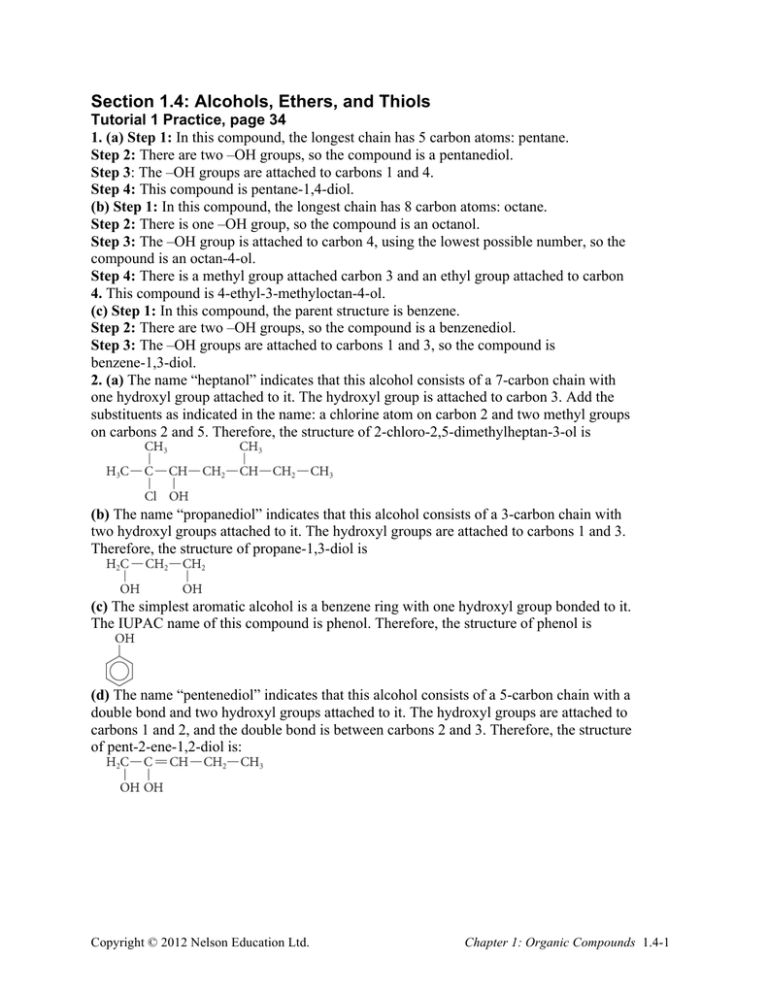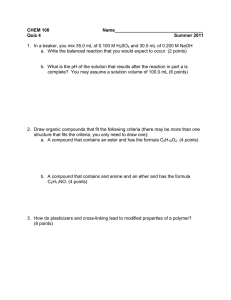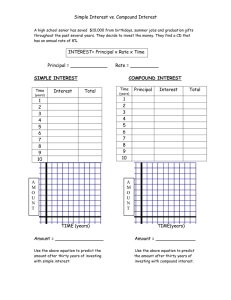Section 1.4: Alcohols, Ethers, and Thiols
advertisement

Section 1.4: Alcohols, Ethers, and Thiols Tutorial 1 Practice, page 34 1. (a) Step 1: In this compound, the longest chain has 5 carbon atoms: pentane. Step 2: There are two –OH groups, so the compound is a pentanediol. Step 3: The –OH groups are attached to carbons 1 and 4. Step 4: This compound is pentane-1,4-diol. (b) Step 1: In this compound, the longest chain has 8 carbon atoms: octane. Step 2: There is one –OH group, so the compound is an octanol. Step 3: The –OH group is attached to carbon 4, using the lowest possible number, so the compound is an octan-4-ol. Step 4: There is a methyl group attached carbon 3 and an ethyl group attached to carbon 4. This compound is 4-ethyl-3-methyloctan-4-ol. (c) Step 1: In this compound, the parent structure is benzene. Step 2: There are two –OH groups, so the compound is a benzenediol. Step 3: The –OH groups are attached to carbons 1 and 3, so the compound is benzene-1,3-diol. 2. (a) The name “heptanol” indicates that this alcohol consists of a 7-carbon chain with one hydroxyl group attached to it. The hydroxyl group is attached to carbon 3. Add the substituents as indicated in the name: a chlorine atom on carbon 2 and two methyl groups on carbons 2 and 5. Therefore, the structure of 2-chloro-2,5-dimethylheptan-3-ol is (b) The name “propanediol” indicates that this alcohol consists of a 3-carbon chain with two hydroxyl groups attached to it. The hydroxyl groups are attached to carbons 1 and 3. Therefore, the structure of propane-1,3-diol is (c) The simplest aromatic alcohol is a benzene ring with one hydroxyl group bonded to it. The IUPAC name of this compound is phenol. Therefore, the structure of phenol is (d) The name “pentenediol” indicates that this alcohol consists of a 5-carbon chain with a double bond and two hydroxyl groups attached to it. The hydroxyl groups are attached to carbons 1 and 2, and the double bond is between carbons 2 and 3. Therefore, the structure of pent-2-ene-1,2-diol is: Copyright © 2012 Nelson Education Ltd. Chapter 1: Organic Compounds 1.4-1 Tutorial 2 Practice, page 37 1. But-1-ene reacts with water in an addition reaction to produce butan-2-ol. The reaction is represented by the following equation: 2. A chemical equation for the dehydration of pentanol is: H 2SO 4 C5H11OH(l) ⎯⎯⎯⎯ → C5H10(l) + H2O(l) Tutorial 3 Practice, page 38 1. (a) This ether has an ethyl group on each side of the oxygen atom. The ether is ethoxyethane. (b) This ether has an ethyl group on one side of the oxygen atom and a propyl group on the other. The ethoxy group is attached to the first carbon in the propyl group. So, the ether is 1-ethoxypropane. 2. (a) The longer carbon chain is propane, which has 3 carbon atoms. The shorter chain is methyl, which has 1 carbon atom. The methoxy group is attached to the second carbon in the propyl group. Therefore, 2-methoxypropane has the following structure: (b) The longer carbon chain is pentane, which has 5 carbon atoms. The shorter chain is ethyl, which has 2 carbon atoms. The ethoxy group is attached to the third carbon in the pentyl group. Therefore, 3-ethoxypentane has the following structure: Section 1.4 Questions, page 39 1. (a) Step 1: In this compound, the longest chain has 7 carbon atoms: heptane. Step 2: There are two –OH groups, so the compound is a heptanediol. Step 3: The –OH groups are attached to carbons 2 and 3. Step 4: This compound is heptane-2,3-diol. (b) Step 1: In this compound, the longest chain has 6 carbon atoms: hexane. Step 2: There is one –OH group, so the compound is a hexanol. Step 3: The –OH group is attached to carbon 2, so the compound is a hexan-2-ol. Step 4: There is a methyl group attached carbon 3. This compound is 3-methylhexan-2-ol. (c) Step 1: In this compound, the longest chain has 7 carbon atoms: heptane. Step 2: There is one –OH group, so the compound is a heptanol. Step 3: The –OH group is attached to carbon 3, so the compound is heptan-3-ol. Step 4: There is an ethyl group attached carbon 4 and a methyl group attached to carbon 5. This compound is 4-ethyl-5-methylheptan-3-ol. Copyright © 2012 Nelson Education Ltd. Chapter 1: Organic Compounds 1.4-2 (d) Step 1: In this compound, the parent structure is cyclopentane. Step 2: There are two –OH groups, so the compound is a cyclopentanediol. Step 3: The –OH groups are attached to carbons 1 and 3, so the compound is cyclopentane-1,3-diol. (e) Step 1: In this compound, the parent structure is benzene. Step 2: There are three –OH groups, so the compound is a benzenetriol. Step 3: The –OH groups are attached to carbons 1, 2 and 4, so the compound is benzene-1,2,4-triol. (f) This is an ether with a propyl group on one side of the oxygen atom and a butyl group on the other. The propoxy group is attached to the first carbon in the butyl group. So, the compound is 1-propoxybutane. (g) This is an ether with an ethyl group on one side of the oxygen atom and a pentyl group on the other. The ethoxy group is attached to the first carbon in the pentyl group. So, the compound is 1-ethoxypentane. (h) This is a thiol with an –SH group at the end of an ethane chain. So, the compound is ethanethiol. 2. (a) The structural formula for 5-bromohexan-3-ol is (b) The structural formula for 2-methylpentan-3-ol is (c) The structural formula for 3,5-dichloropentan-2-ol is (d) The structural formula for cyclobutane-1,2-dithiol is (e) The structural formula for 2-methoxyheptane is (f) The structural formula for cyclohex-4-ene-1,3-diol is Copyright © 2012 Nelson Education Ltd. Chapter 1: Organic Compounds 1.4-3 3. Answers may vary. Sample answer: Ethanol is a primary alcohol with a short carbon chain. Heptan-2-ol is a secondary alcohol with a relatively longer carbon chain. Since simple alcohols with short carbon chains are more soluble in water than those with longer carbon chains, a solubility test can be used to identify the two compounds. Dissolve a sample of an equal amount of either compound in water. The one that is more soluble is ethanol. Another test is to perform a dehydration reaction using sulfuric acid as a catalyst on each alcohol to change it to an alkene. The dehydration of ethanol, which is a primary alcohol, will produce only one alkene—ethene. For the dehydration of heptan-2-ol, which is a secondary alcohol, a mixture of two different alkenes—heptenes—will be produced. 4. (a) The reaction of hept-1-ene with water is an addition reaction, or hydration, of an alkene. The product will be heptan-2-ol. (b) The reaction of butan-1-ol with sulfuric acid catalyst is a dehydration reaction of a primary alcohol. The products will be but-1-ene and water. (c) The reaction of propan-1-ol with ethanol is a condensation reaction for ether synthesis. The products will be 1-ethoxypropane and water. 5. The equation that represents the complete combustion of methanol is: 2 CH3OH(l) + 3 O2(g) → 2 CO2(g) + 4 H2O(g) 6. Answers may vary. Sample answer: The chemist can react ethene with water using an acid as a catalyst to change ethene to ethanol. She can also react pent-1-ene with water using an acid as a catalyst to change pent-1-ene to pentan-1-ol. 1-ethoxypentane can then be synthesized from the condensation reaction of ethanol and pentan-1-ol using sulfuric acid as the catalyst. 7. Answers may vary. Sample answer: This section is about alcohols, ethers, and thiols. Many sulfur-containing compounds, such as hydrogen sulfide, are known for their smell of rotten eggs. Thiols are also compounds that contain sulfur. So, the types of compounds that are present in rotten eggs are likely thiols. In fact, simple thiols have strong odours of rotten eggs, which can be detected by humans in the air at very low concentrations. Copyright © 2012 Nelson Education Ltd. Chapter 1: Organic Compounds 1.4-4




